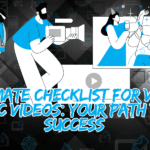Introduction
In the competitive world of direct-to-consumer (D2C) marketing, creating viral videos can significantly boost brand visibility and sales. This comprehensive checklist provides a step-by-step guide across preproduction, production, and post-production phases to ensure your D2C video hits all the right notes for virality.
Preproduction Phase
Identify Your Audience
- Research target demographics and psychographics.
- Understand audience pain points and interests.
- Create detailed buyer personas.
Define Clear Objectives
- Set specific, measurable goals (e.g., brand awareness, product launch, sales increase).
- Align video content with overall marketing strategy.
Develop a Compelling Concept
- Brainstorm unique, relatable ideas.
- Focus on storytelling that evokes emotions.
- Ensure the concept aligns with brand values.
Scriptwriting
- Write a concise, engaging script.
- Include a strong hook in the first few seconds.
- Use simple, clear language and a conversational tone.
Storyboard Creation
- Visualize the script with a detailed storyboard.
- Plan each scene, shot, and transition.
- Ensure visual consistency with the brand aesthetic.
Casting and Crew
- Choose charismatic, relatable actors.
- Hire experienced directors, videographers, and editors.
- Ensure the team understands the video’s objectives and brand vision.
Location Scouting
- Select visually appealing, relevant locations.
- Obtain necessary permits and permissions.
- Plan for backup locations in case of unforeseen issues.
Production Planning
- Create a detailed production schedule.
- Plan for contingencies (weather, equipment failure).
- Organize all necessary equipment and props.
Production Phase
Set Up
- Ensure all equipment is functioning correctly.
- Set up lighting, sound, and camera positions.
- Conduct rehearsals with actors.
Filming
- Stick to the storyboard but be open to creative improvisation.
- Ensure audio and visual quality is top-notch.
- Capture B-roll footage for additional editing flexibility.
Directing
- Maintain a positive, encouraging environment.
- Provide clear, constructive feedback to actors and crew.
- Keep the focus on the video’s objectives and message.
Monitoring
- Regularly review footage to ensure it meets expectations.
- Make necessary adjustments on the spot.
- Ensure continuity in scenes and transitions.
Post-Production Phase
Editing
- Start with a rough cut to outline the video.
- Fine-tune cuts for smooth transitions and pacing.
- Add engaging music, sound effects, and voiceovers.
Visual Effects and Graphics
- Incorporate brand logos, colors, and fonts.
- Use visual effects to enhance the storytelling.
- Ensure all graphics are high quality and relevant.
Sound Design
- Balance audio levels for clarity.
- Add background music that complements the video’s tone.
- Ensure sound effects are synchronized with visual elements.
Review and Feedback
- Conduct multiple review rounds with the team.
- Gather feedback from a diverse group (marketing, creative, audience representatives).
- Make necessary revisions based on feedback.
Optimization
- Format the video for different platforms (Instagram, YouTube, Facebook).
- Add captions for accessibility and wider reach.
- Optimize video length based on platform best practices.
Distribution and Promotion
Platform-Specific Strategies
- Tailor video descriptions, tags, and thumbnails for each platform.
- Utilize platform-specific features (Instagram Reels, YouTube Shorts).
- Schedule posts for optimal engagement times.
Engagement Tactics
- Create teasers and behind-the-scenes content.
- Encourage viewers to like, share, and comment.
- Engage with the audience by responding to comments and messages.
Analytics and Performance Tracking
- Monitor key metrics (views, shares, engagement rates).
- Use analytics tools to gain insights into audience behavior.
- Adjust future strategies based on performance data.
A/B Testing
- Test different versions of the video to see what resonates best.
- Experiment with various titles, thumbnails, and calls-to-action.
- Use results to refine your approach.
Paid Promotion
- Invest in targeted ads on social media platforms.
- Utilize influencer partnerships for wider reach.
- Track ROI to ensure promotional activities are cost-effective.
Iterate and Improve
- Continuously gather feedback and analyze performance.
- Adapt to trends and audience preferences.
- Refine your process for creating viral content.
Conclusion
Creating a viral D2C video involves meticulous planning, creative execution, and strategic promotion. By following this comprehensive checklist, you can increase the likelihood of your videos achieving viral success, driving engagement, and boosting your brand’s visibility.
FAQ
Engaging content, strong emotional appeal, high-quality visuals, and strategic promotion.
Understanding your audience is crucial for creating content that resonates and engages effectively.
Storytelling helps to connect with viewers on an emotional level, making the content more memorable and shareable.
Tailor the video format, length, and captions to fit the specifications and audience behavior of each platform.
Leverage social media ads, influencer partnerships, and cross-promotion to maximize reach.
Track metrics such as views, shares, engagement rates, and conversions to gauge the video’s performance.






Leave a Reply
You must be logged in to post a comment.